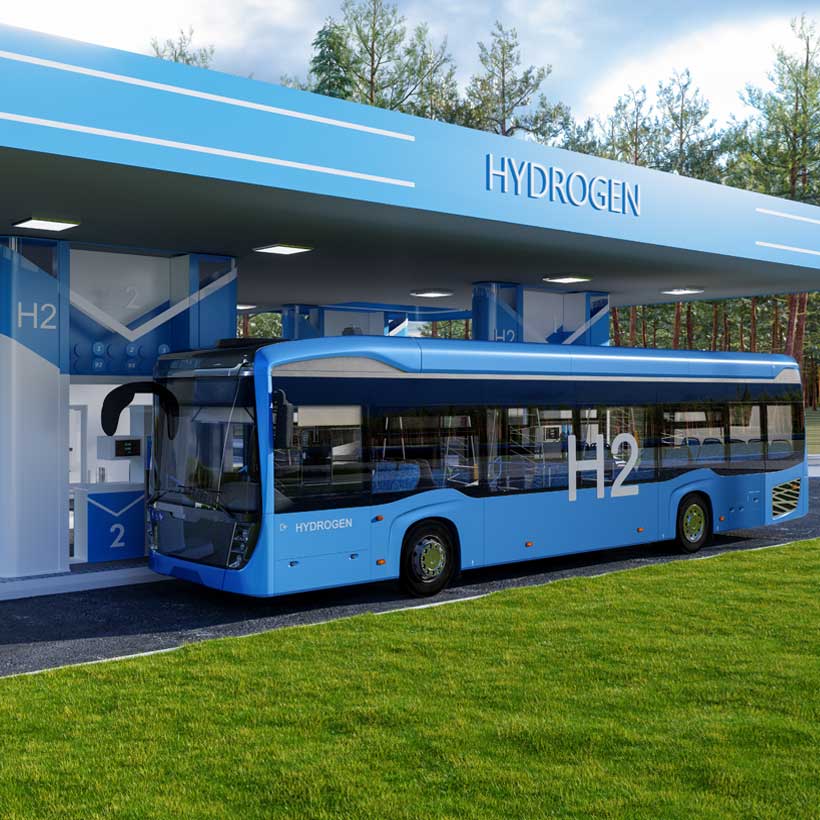Fuel Cell Electric Vehicles (FCEVs)
Over the past few years, the transport sector has witnessed the introduction and development of different types of hydrogen-powered vehicles: cars, vans, buses, trucks – and their associated infrastructure. Although the use of hydrogen fuel cells in HDVs (heavy duty vehicles), such as trucks, is still relatively new, significant efforts have recently been made to introduce them into these vehicles, as they account for a substantial share of carbon emissions.
A study on fuel cell hydrogen trucks commissioned by the Fuel Cells and Hydrogen Joint Undertaking was released in December 2020 and revealed that by 2030, there could be as many as 110,000 fuel cell hydrogen trucks on European roads, avoiding up to 11 million tonnes of CO2. However, several technical and non-technical barriers still must be addressed to unlock the full commercial potential of hydrogen trucks.
One of these barriers are loadings. Platinum loadings on FCEVs have already decreased by over 90% since the early 1990s, with a further reduction in platinum loadings expected as the efficiency with which the metal is used in proton exchange membran (PEM) fuel cells continues to improve through R&D – this is very typical in PGM applications.
Expected development in platinum loadings
Average FCEV loadings are around 45 g per vehicle today (a weighted average across all passenger and commercial vehicle classes) and, according to our member Johnson Matthey, both a two-fold and three-fold improvement in metal intensity per vehicle by 2050 can be expected - i.e. a 50% thrift to 23 g / vehicle on average, and a 67% thrift to 15 g / vehicle (source: Johnson Matthey Whitepaper 2023 “Platinum – a sustainable solution for the energy transition”)
Accelerated development of fuel cells for use in heavy-duty trucking promises to boost infrastructure and bring the economies of scale needed to hasten light-duty fuel cell electric vehicle (FCEV) adoption. The Hydrogen Council expects that FCEV passenger cars could represent almost 3% of new vehicle sales in 2030, ramping up to about 35% in 2050, for total sales of 4 million vehicles in 2030. In the markets leading global FCEV adoption – Germany, Japan, California, and South Korea – almost every 12th car sold in 2030 could be powered by hydrogen.
Fuel cell buses are also getting significant traction due to concerns about local pollution, particularly in Europe, Japan, South Korea, and China. While smaller buses and buses with shorter-range requirements might run on batteries, fuel cells will allow larger buses to go longer distances and operate with fewer interruptions. For buses, the infrastructure hurdle is less relevant, as most rely on purpose-built refuelling stations.

What are fuel cells and where are they used?
Fuel cells are electrochemical devices that convert the energy of a chemical reaction directly into electricity, with heat and water as by-products. The fuel and oxidant (oxygen or air) are supplied externally, enabling them to continue operating as long as they are fed. So, unlike batteries, they never "run out".
Hydrogen, when used in a fuel cell, generates power electrochemically with only water as the by-product. This means that fuel cells can create power without releasing any harmful emissions or particulates.
Platinum and ruthenium play a large role in this technology. Platinum is the catalyst which converts hydrogen and oxygen to heat, water, and electricity. Palladium will likely also play a role in the fuel cell, but it is unknown yet how big.
Many believe that the fuel cell engine, comprising a fuel processor, fuel cell stack and power conditioner, will ultimately take the place of the internal combustion engine as the dominant technology for vehicles from cars to trains.






